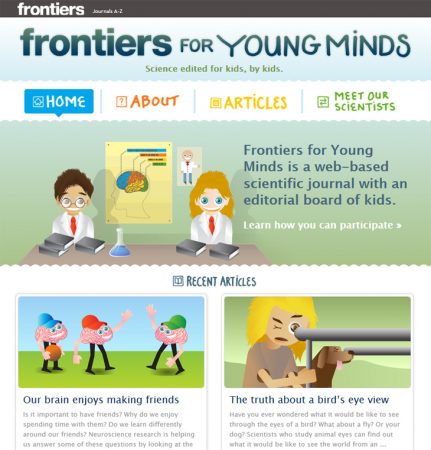Science site brings the brain to young minds
Writing about science for young people is hard. There are many rules, and even more little tricks. Don’t swear (of course). No passive voice. Stay away from commas, and never use a semicolon. Avoid words with more than three syllables. Keep sentences short. Define everything. Don’t condescend. The minds may be young but they aren’t stupid.
But even if you follow all of these guidelines, you can’t just hand sixth grade students an article about optogenetics and expect them to “get it.” When someone doesn’t know about cellular receptors or neurons, or even that different areas of the brain do different things, you’ve got a lot of background to get through. Students need writing about science that is for them. They need writing that provides the background they need and that does not treat them like they are less intelligent than an adult.
So I was very pleased to hear about the new website Frontiers for Young Minds. It is a neuroscience journal for kids. Scientists write review articles and submit them to the website. Then, editors at the journal enlist help from kids. Children ages 5-16 serve as assistant editors. They read the articles (with some adult help) and give feedback on what they understand and what needs to change. The site is colorful and is full of cartoon art and lots of pictures.

The website is still pretty new. There are only about 15 articles so far, with another batch due out in April. The website is targeted at kids from 8 to 15 years old. Knight says that kids are eager to help out, and the response has been huge. The Frontiers for Young Minds Twitter feed is full of scientists exclaiming over how cool the idea is, and calling it “the best sci-publishing launch in decades.” Science teachers are also enthusiastic. Peter Pinko, a science teacher at Dorseyville Middle School in Pittsburgh, Pa., describes the site as “excellent,” and notes that he will be recommending it to his students.
The site aims to fill an important educational gap. But the execution needs some improvement. Working scientists write the articles. This is great, but it means that sometimes the articles use awkward language and scientific jargon. There are phrases like “Here, I shall deal with the topic of how our school education can influence our brain, focusing particularly on the changes in the cerebral cortex induced by our surroundings.” Kids may read that and give it the OK, but I’m not sure they “get” what they’re reading. With such difficult writing, even topics designed to appeal to kids, like Facebook and the brain, suddenly seem less exciting. Some of the pieces would benefit from more editing.
The readability level of the articles also varies. An article on “going to school to sculpt the brain” had a 10-year-old reviewer. But the final readability level is a Flesch-Kinkaid grade level of 13.3, a reading level better suited to a college freshman. An article on video games, reviewed by two 5-year-olds, had a score of 10.8. Fred Fenter is the executive editor of Frontiers for Young Minds. He notes that right now most of the youth editors have neuroscientist parents, and he acknowledges that many of these kids “are probably reading at a much higher level than your average 13-year-old.” The articles on the site reflect that bias.
So far, the site’s editors say they are not measuring readability. In addition, while they have recorded a large number of views on the site, some of them from school addresses, they cannot tell how many kids are actually using it. It’s also hard to estimate the age of most of the visitors to the site and what they are getting out of it. While the site has great intentions, they will have to get past these growing pains before becoming a resource that most kids can comprehend.
Fenter says that in the future, he hopes to “aim more consistently at the same age level.” He also emphasizes that as the site grows, he wants it to appeal to everyone. “We don’t want this to be a website for the elites,” he says. “We want this to be a resource that teachers can use in any public school.”
Next, Knight and Fenter hope to get science teachers involved. Teachers could work with their classrooms to review articles. They also want future articles to focus on cutting-edge science. The current articles are reviews of general neuroscience subject matter, but Knight wants to include more recently published neuroscience papers. And in the end, the real focus is on the kids. “In this journal,” he says, “it’s not getting published unless the kids understand it.”
Power words
cortex The outermost layer of neural tissue of the brain.
neuron or nerve cell Any of the impulse-conducting cells that make up the brain, spinal column and nervous system. These specialized cells transmit information to other neurons in the form of electrical signals.
neuroscience Science that deals with the structure or function of the brain and other parts of the nervous system. Researchers in this field are known as neuroscientists.
optogenetics A technique that uses light to better understand genes and cells in the nervous system, especially the brain.
receptor (in biology) A molecule in cells that serves as a docking station for another molecule. That second molecule can turn on some special activity by the cell.